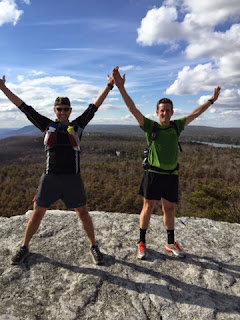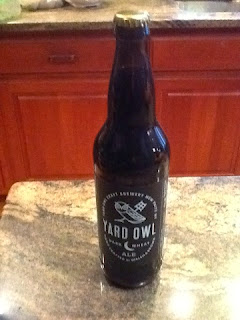As I mentioned in
my post on the Shawangunk Ridge Trail Run, the Wagathon is my favorite fat ass run. "The Wag," named after the rock-climbers' club Westchester Alpine Group, was started in 2005 by climbing legend Felix Modugno and was, in its early years, exclusively a climber's deal; the first three years featured fields of about 3-8 people, all climbers, none of whom ran with any real regularity. But somehow people started to talk, and in my first year, 2008, we suddenly had almost 30 people at the start.
 |
| The start of Wag IV, 2008 |
The first four years, the course didn't vary much; starting in Sam's Point Preserve, the trail passed Verderkill Falls and Mud Pond on its way to Lake Awosting, Millbrook Mountain, and down to Trapps Bridge; after that, we followed mostly carriage roads up to Skytop at Mohonk Mountain House and then back down through the Preserve into the town of New Paltz, finishing at the
Gilded Otter Brewing Company, a distance of about 30 miles. I "won" the fourth edition in 2008, running a basically solo 4:07, and had a great time. In 2009, the course changed slightly, adding the beautiful but difficult Gertrude's Nose trail and finishing outside town at the climber's haven, the
Mountain Brauhaus. By this time plenty of runners had joined the hardcore climbing contingent, and from that year on the run became more runner-dominated than climber-dominated. I ran most of the 2009 race with Scott Willett, an elite triathlete and the founder of the
Tri-Life training group, and we tied for the "win". In 2010 the course changed again, now finishing in Rosendale at the northern end of the Shawangunk ridge; I dropped out with an injury halfway through, but returned in 2011 to share the win with Glen Redpath, my third "win" in four tries.
By this time, organizational duties had passed from Felix, through local ultra runner Joe Brown, and on to Mike Siudy, a climber in his past life who now passes his time running insanely difficult ultra courses through the Catskills. Mike standardized the course, which had started to fluctuate quite a bit from year to year, and basically codified it into what it is today: a nearly 30-mile trip from Sam's Point to Rosendale, covering single track, carriage roads, and five rock scrambles, including the infamous Giant's Workshop, Lemon Squeeze, and Bonticou Crag. Also starting in 2012, the structure of the event changed. While it was always a fat ass event--no entry fee, no support, no awards, few rules--the run had, for the first seven years, had a mass 9 am start. While the vibe was decidedly friendly and relaxed, there was certainly a mild competitive undertone, and part of the fun (for me at least) was trying to lay down a fast performance and be one of the first people sipping beer at the
Red Brick Tavern at the end. But after seven years in this style, people wanted a change--specifically, some of the faster finishers wanted to share drinks with some of the slower folks, but didn't want to have to wait several hours for everyone to get in. So starting in 2012, the run became completely non-competitive: start whenever you want, just try to time it so you finish between 4 and 5 pm, so we can all eat, drink, and be merry together.
 |
| Phil and Brian at Verderkill Falls |
I liked the thought, and admired the impulse toward mass drunkenness, but losing the competitive aspect did kill some of my interest in the event. The logistics of the run aren't easy--Sam's Point is a good hour's drive from the finish in Rosendale, and it was hard to justify the headache of planning everything out for what now amounted to a long run on most of the same trails I run on every weekend. Plus, I'm not exactly what you'd call "great" with heights, and some of the more exposed, tricky rock scramble sections are really not my cup of tea. I never like feeling like I'm about to fall to my death, especially not 25 miles into a 5-6 hour effort. So for a few years, I was out on the Wag. But 2014 marked the 10th anniversary of this venerated event, and two of my good friends and training partners, Brian Oestrike and Phil Vondra, were excited to run it for their first time. Glen was coming up from the city as well, running half the race as his longest run since Achilles' surgery in July. Phil and I had the seemingly brilliant idea to stash a couple of beers out on the course, which we did the night before, and by 10:45 Brian, Phil, and I were heading off toward Verderkill Falls with the goal of finishing by around 4:30.
 |
| "W" is for Wagathon--at Castle Rock |
We wound up with a near-perfect day of weather and had a great time chatting it up as we navigated the tricky single track past the falls and out to Lake Awosting. From there, we followed carriage roads over Castle Rock and headed out toward Millbrook Mountain. On the way, we caught up with Josh Burns, who had started a few minutes before us, and the four of us kept up a pretty solid pace to Trapps Bridge, 15 miles into the run and the site of our first beer stop. We dropped a few hints to Josh about the beer, but as we approached the bridge, he announced that he was going to keep going up onto the ridge, and he was gone before any of us could say, "Hey, wait, there really is beer here." Phil had left us a nice 750ml bottle of
Aria from Perennial Brewery, which took us a good 15 minutes to plow through before heading back out on to the trail.
 |
| Beer stop #1. Photo: Phil Vondra |
From there, things got a bit wobbly. The next few miles are a tricky traverse along the top of Trapps Cliff, and while we were pretty pleased with ourselves for having had the forethought to have a beer stop, we were clearly moving rather slowly and stiffly along. After a few quiet minutes of slogging, Brian commented, "Man, we are really in the doldrums." Apparently beer with 8% ABV is not a performance enhancer.
 |
| In the doldrums, at checkpoint #3. Photo: Phil Vondra |
The course gets worse before it gets better--we slogged our way through Giants' Workshop and the Lemon Squeeze, which Brian negotiated easily with his alpinist background, but I suffered quite a bit until we got past Skytop tower and started running again back downhill. We hit a nice rhythm, though, and had cranked out a good couple of miles before we reached beer check #2, hidden behind the Mohonk Golf Course: a nice
Yard Owl Dark Wheat:
 |
| No caption necessary. |
There were no two ways about it after that: I was basically drunk, and Phil and Brian kept a pretty close eye on my on the scramble up to Bonticou Crag. By the time we made our way back down the Northeast Trail and through the swamp at the bottom of the Widowmaker, I was almost back to normal, and all that was left was the final few miles racing the sunset. We finished up in just over 6 hours, including the beer stops, with about 5:15 of actual running time--not too far off what we had planned, actually. It was Phil's longest run ever, and all in all, we had a really fun day out. I have to admit, it was fun seeing everyone at the finish, though I do miss the competitive aspect of it a bit.
Quick gear report: I used the
Montrail Rogue Racer, the shoe I've been putting in the vast majority of my miles for the past few months. They're only 9 oz, and billed as a racing flat, but they have a 9mm drop and a fair bit of cushion, and I've been very happy with them for many miles and several long efforts. I wore my
Pearl Izumi Ultra Split short which is a brilliant piece of clothing. The pockets in the back of these shorts are actually sewn into the liner, which comes all the way up to the top of the short, so you can carry gels or your phone (the main pocket zips and holds an iPhone 6) with virtually no bouncing. They're quite expensive for shorts but a fairly indispensable item. And, as on most long unsupported efforts I used the
Ultimate Direction AK Race Vest for hydration. Though the day after this run I received in the mail the
Orange Mud HydraQuiver, which may replace the UD vest as my go-to hydration system for longer runs. More details to come!
















